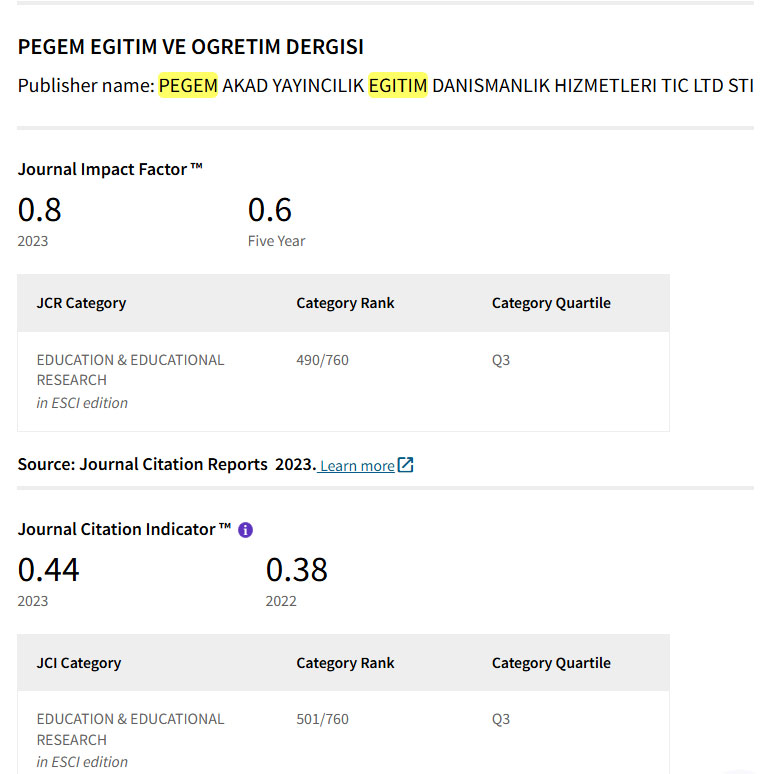Confirmation Gestures, Mimics and their Effects on Foreign Language Learning: Examples of EFL Students
DOI:
https://doi.org/10.47750/pegegog.15.03.12Keywords:
nonverbal communication, gestures, foreign language, body language, intercultural differences, communication skillsAbstract
Most of the communication in the classroom is provided non-verbally through body language. It was observed that non-verbal communication from abstract concepts to concrete concepts, as well as verbal communication, was effective during the lecture carried out by the teacher. Being able to use body language effectively is considered one of the most important factors in achieving success in education where communication is important. It is known that the words spoken, tone of voice and body language used in the desired or expected manner have serious effects on individuals who are learning. In classroom communication, visual behavior is as important to the audience as the content of the subject being explained. Being able to use the individual's posture, facial expressions and body organs appropriately adds motivation to learning during the learning process and saves the environment from being bored. In this study, the definition and elements of nonverbal communication, the teacher's gestures and facial expressions, his gaze, his stance in the classroom, his self-confidence and the effects of body language on the lesson are explained. At the end of the study, the benefits of teachers' effective use of body language, the mistakes made regarding the use of body language and the suggestions made for these are mentioned.
Downloads
References
BABACAN,Ç. (2011). Öğretmenler İçin Beden Dili. Türkiye:Elma Yayınevi
Baltaş, Z. ve Baltaş, A. (2019). Renkli Resimlerle Bedenin Dili. (53. Baskı). İstanbul: Remzi Kitapevi.
Cook, S., Duffy, R. ve Fenn, K. (2013). Consolidation and transfer of learning after observing hand gesture. Child Development, 84, 1863–1871. doi:10.1111/cdev.12097
KARASAR, N.(2012). Bilimsel Araştırma Yöntemi .Ankara :Nobel Akademik Yayıncılık,
Mirici, I. H. (2000). European Language Portfolio: A tool for a common language education policy in Europe. Journal of Interdisciplinary Education, 6(1), 161-166.
McKay, (2003). Teaching English as an International Language: Rethinking goals and approaches.Oxford University Press
İzgören, A. Ş. (2019). Dikkat Vücudumuz Konuşuyor. (86. Baskı). Ankara: Elma Yayınları
Tekindal, M. & Arsu, Ş. U. (2020). Nitel araştırma yöntemi olarak fenomenolojik yaklaşımın kapsamı ve sürecine yönelik bir derleme. Ufkun Ötesi Bilim Dergisi, 20(1), 153-172
Uysal, S. & Özdemir, C. (2023). Yabancı Dil Olarak Türkçenin Soydaşlara Öğretiminde Konuşma Becerisinin Gelişimini Etkileyen Faktörlerin Tespiti. IJSS, 7(31), 759-770
Karsenti, T. (2019). Artificial intelligence in education: the urgent need to prepare teachers for tomorrow’s schools. Formation et profession, 27(1), 112-116.
Mumford, K. H. ve Kita, S. (2014). Children use gesture to interpret novel verb meanings. Child Development, 85(3), 1181-1189. doi:10.1111/cdev.12188
Özçalışkan, Ş., Lucero, C. ve Goldin-Meadow, S. (2016). Does language shape silent gesture? Cognition, 148, 10–18. doi: 10.1016/j.cognition.2015.12.001 doi: 10.1016/j.cognition.2015.12.001
Ünal, E. ve Papafragou, A. (2016). Interactions between language and mental representations. Language Learning, 66, 554-580. doi:10.1111/lang.12188.
Sysoyev, P.V.&Donelson L.R. (2004). Teaching Cultural Identity through Modern Language: Discourse as a Marker of an Individual’s Cultural Identity.
Grudin, J., & Jacques, R. (2019). Chatbots, humbots, and the quest for artificial general intelligence. In Proceedings of the 2019 CHI conference on human factors in computing systems (pp. 1–11). ACM
Downloads
Published
How to Cite
Issue
Section
License
Copyright (c) 2025 Pegem Journal of Education and Instruction

This work is licensed under a Creative Commons Attribution-NonCommercial 4.0 International License.
Attribution — You must give appropriate credit, provide a link to the license, and indicate if changes were made. You may do so in any reasonable manner, but not in any way that suggests the licensor endorses you or your use.
NonCommercial — You may not use the material for commercial purposes.
No additional restrictions — You may not apply legal terms or technological measures that legally restrict others from doing anything the license permits.



